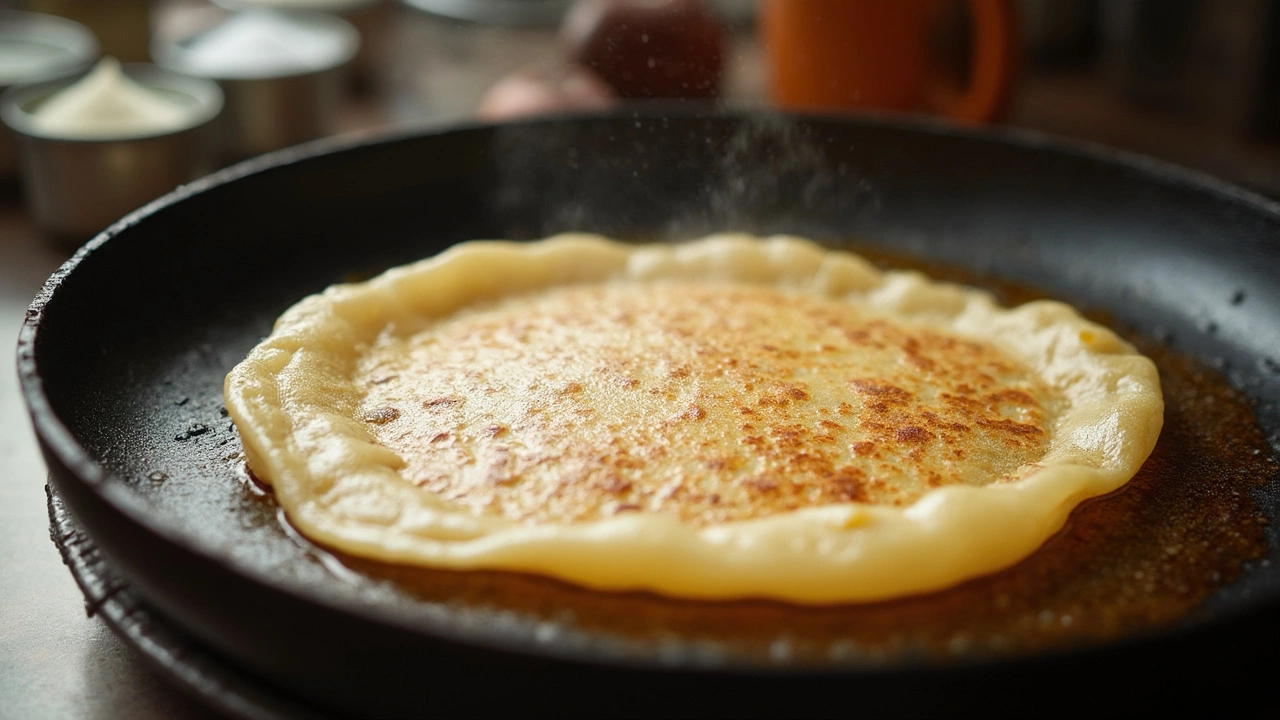If you're keen on making the perfect dosa, understanding baking soda's role in the batter is a game-changer. Baking soda isn't just for cakes and cookies; it has a magical touch when it comes to improving the texture and taste of dosas.
Adding baking soda can speed up the fermentation process, especially if you're short on time or if the weather isn't warm enough to naturally ferment your batter. But here's the catch – timing is everything! Adding it too early or too late can lead to a less-than-ideal result.
- Understanding the Role of Baking Soda
- Ideal Timing for Adding Baking Soda
- How Much Baking Soda to Use
- Common Mistakes to Avoid
Understanding the Role of Baking Soda
When it comes to making the perfect dosa batter, knowing when and how to add baking soda is crucial. But what's its real role? Well, first off, baking soda acts as a leavening agent. It helps the batter rise by creating tiny bubbles, which result in a lighter and fluffier dosa—just what you're aiming for!
One of baking soda's key benefits is its ability to enhance the batter's fermentation process. Normally, fermenting dosa batter involves natural bacteria in the rice and lentils breaking down and releasing carbon dioxide. This can be slow, especially in cooler climates. Adding a pinch of baking soda can hasten this process, especially if you’re pressed for time.
How Does It Work?
When you introduce baking soda into the batter, it's like giving it a boost. The soda reacts with the acids in the batter, releasing carbon dioxide faster. This reaction is crucial for that crispy exterior and fluffy interior we all love in a dosa.
Science Behind the Scenes
The chemical formula for baking soda is NaHCO₃, and when it interacts with acids in the batter, you get this simple reaction:
- When combined with acids: It releases CO₂, which helps the batter rise and create airy texture.
- Enhanced browning: The reaction also contributes to better browning on the surface of the dosa, giving you that perfect golden hue.
Useful Tip
If you're using store-bought batter, remember that it often already has a leavening agent. In such cases, adding more baking soda might not be necessary and could even make your dosas excessively fluffy or taste off. It's always a good idea to conduct a small test batch to find the balance that works best for your taste!
Ideal Timing for Adding Baking Soda
Choose the right moment to add baking soda to your dosa batter, and you’re halfway to perfect dosas. The golden rule? Timing is everything!
Baking soda is typically added just before you start making the dosas, right after the fermentation process. Why? Because it acts fast, producing carbon dioxide that gets trapped in the batter, making it rise and produce those delightful airy gaps when you cook them.
Why After Fermentation?
During fermentation, the natural bacteria and yeast in the batter break down the sugars, resulting in a tangy flavor and natural leavening. Adding baking soda before this process could mess with the batter's integrity, since the soda depletes and loses its magic.
Danger of Early Addition
Introduce baking soda too early, and you might find your batter over-fermented or even flat once you start cooking. This can result in dense, chewy dosas rather than the light, crispy ones you’re aiming for.
Ready to Cook
Once fermentation is complete, give the batter a gentle stir. At this point, add approximately a pinch of baking soda per cup of batter, just enough to boost that fluffiness without altering the taste.
A fun little tip: when you’re unsure about the batter’s readiness, keep an eye for bubbles forming after adding the soda. That’s your sign that the batter is well-aerated and ready to create delicious, crispy dosas.

How Much Baking Soda to Use
When it comes to getting the right amount of baking soda in your dosa batter, less is definitely more. The trick is to add just enough to help with the fermentation and fluffiness without overpowering the batter's natural taste.
A good rule of thumb is to use about 1/4 teaspoon of baking soda for every cup of batter. This small amount is usually sufficient to give your dosas the lift and lightness you're after.
But remember, it's not just about measurement; consistency matters too. After you mix in the baking soda, let the batter sit for a few more minutes. This step allows the soda to react with the natural acids in the batter and maximize its effect.
Tips for Success
- Always add baking soda right before cooking. Mix it just as you're about to ladle the batter onto the pan for immediate results.
- If you're using a premixed or store-bought dosa batter, check the ingredients first. Some brands might already include leavening agents.
Lastly, while it might be tempting to add more baking soda for extra rise, resist the urge. Too much can make the batter bitter and will affect the golden crispiness of the dosa.
If this all sounds straight out of a chemistry class, that's because it kind of is! The interaction between baking soda and fermented batter is a neat little science trick that turns your everyday dosa into a fluffy delight.
Common Mistakes to Avoid
When making dosa batter, using baking soda to perfect the texture can be a little tricky. Here are some pitfalls to avoid if you want your dosas to turn out just right.
Adding Baking Soda Too Early
This is a big one. If you add baking soda during the initial mixing of the dosa batter, the effect might wear off before you cook the dosas. Baking soda starts working immediately, so it's best to add it just before you start the frying process.
Using Too Much Baking Soda
A little goes a long way! Using too much baking soda affects the taste and makes the dosas bitter. A pinch or about 1/8 teaspoon per cup of batter should be sufficient.
Skipping the Salt
Salt is essential when using baking soda, as it helps to activate the soda properly. Don't forget to add salt for both flavoring the batter and getting the right reaction with the soda.
Ignoring Temperature and Environment
Dosa fermentation is highly dependent on your environment. If it's cold, you might need extra help for fermentation to get the batter ready. Baking soda is useful when the weather isn't on your side, but remember not to rely solely on it. Try some natural fermentation methods first.
Preparing a Large Batch
While it may seem efficient, making a large batch of batter and adding baking soda won't work if you're planning to store it for long. The soda's effect diminishes over time, so if you're making dosas over several days, add fresh baking soda each time you cook.
Avoiding these common mistakes can help you achieve perfect, crispy dosas every time! Being mindful of when and how to add baking soda can help avoid many kitchen woes.
